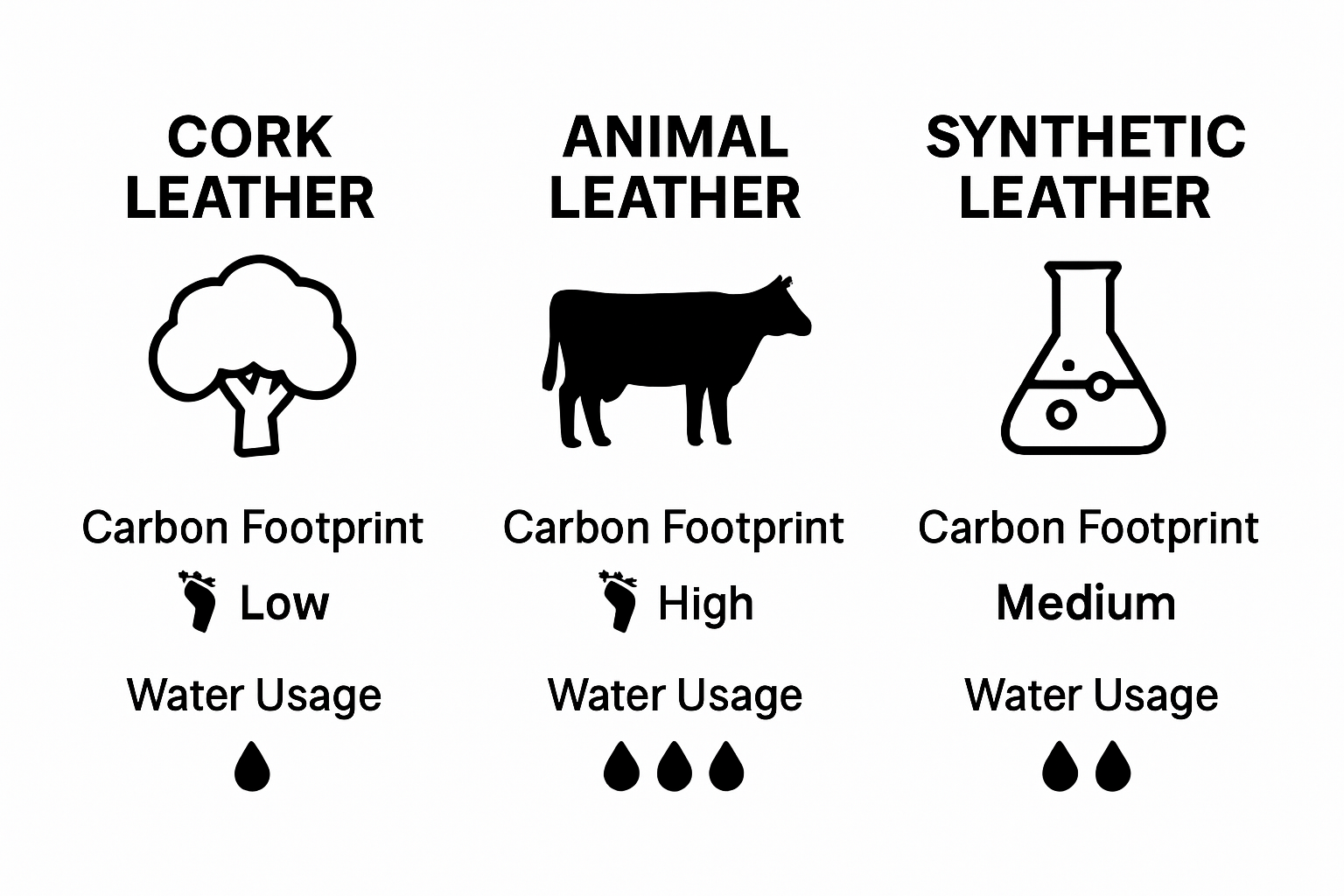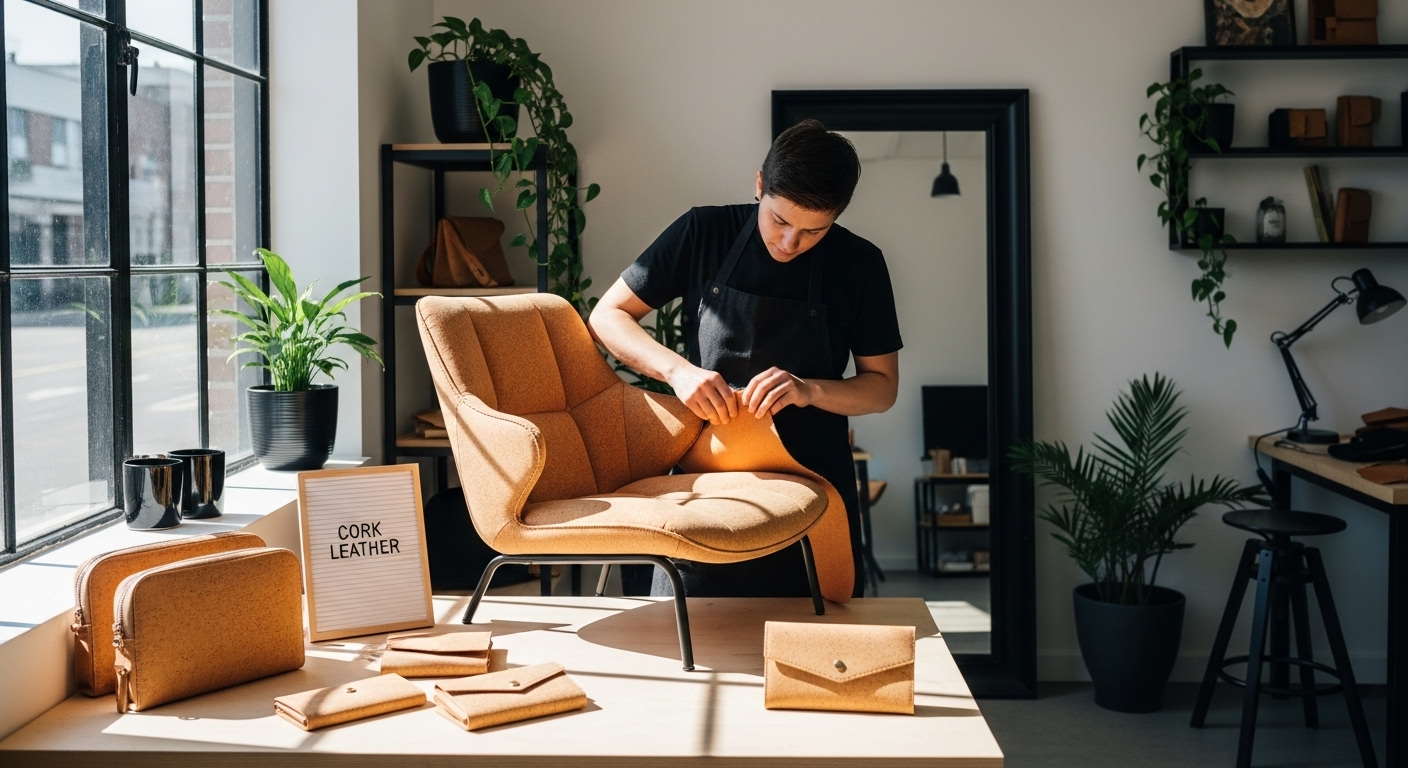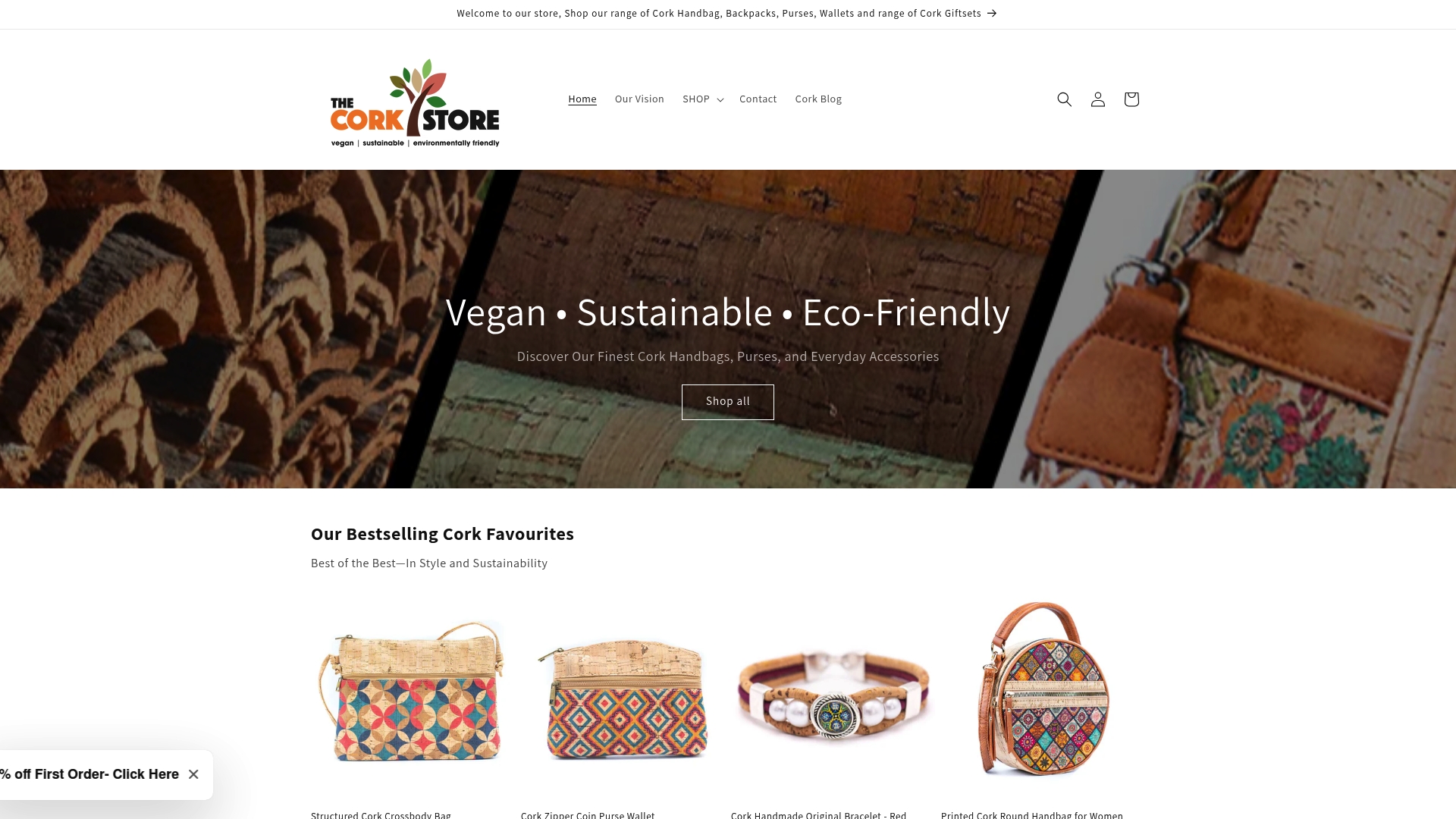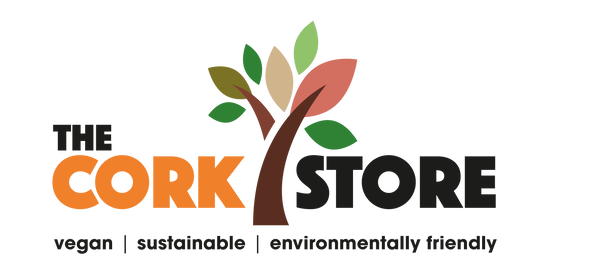
Understanding What is Cork Leather and Its Benefits
Share
Cork leather might sound like an odd twist for eco style, but it is quickly becoming a star in sustainable fashion. Most people expect vegan leather to mean plastic, yet cork leather comes from tree bark that can be harvested every 9 to 12 years without harming the tree at all. It is not just about looking good and feeling soft. Cork leather is proving to be one of the most environmentally responsible materials you can own and that surprises nearly everyone.
Table of Contents
- The Basics: What Is Cork Leather?
- The Sustainability Factor: Why Cork Leather Matters
- How Is Cork Leather Made? Exploring The Process
- Comparing Cork Leather: Key Features And Benefits
- Real-World Applications: Where Is Cork Leather Used?
Quick Summary
| Takeaway | Explanation |
|---|---|
| Cork leather is eco-friendly. | It offers a sustainable alternative to traditional leather, derived from the renewable bark of cork oak trees. |
| Lightweight and durable material. | Cork leather is known for its flexibility and resistance to wear, making it ideal for fashion accessories. |
| Ethically sourced and produced. | The harvesting process supports local communities and protects cork oak forests, promoting social responsibility. |
| Low environmental impact. | Cork leather requires minimal water and has a significantly lower carbon footprint compared to animal leather. |
| Versatile applications across industries. | It is used in fashion, interior design, and more, showcasing its adaptability and sustainability in various fields. |
The Basics: What is Cork Leather?
Cork leather represents an innovative and sustainable alternative to traditional animal leather, offering an eco-friendly solution for fashion and accessory production. Derived from the bark of cork oak trees, this material transforms a natural resource into a versatile textile with remarkable properties. Learn more about sustainable fashion materials.
Origin and Manufacturing Process
The production of cork leather begins with harvesting bark from cork oak trees without harming the tree itself. Skilled workers carefully strip thin layers of bark, which naturally regenerates over time, ensuring a renewable and environmentally responsible process. According to research from the European Forest Institute, cork oak forests play a crucial role in carbon sequestration and ecosystem preservation.
Once harvested, the cork bark undergoes a sophisticated transformation.
Manufacturers slice the bark into extremely thin sheets, which are then treated, processed, and bonded with fabric backing to create a flexible, durable material that mimics traditional leather’s texture and appearance. The resulting cork leather maintains several key characteristics:
- Lightweight and extremely flexible
- Water-resistant and naturally antimicrobial
- Hypoallergenic and free from harmful chemicals
Unique Material Properties
What distinguishes cork leather from other materials is its exceptional combination of sustainability and performance. The natural cellular structure of cork provides unique advantages that make it an outstanding alternative to animal leather. Its microscopic air pockets create inherent cushioning and resilience, while its surface remains smooth and elegant.
Cork leather exhibits remarkable durability, resisting wear and tear more effectively than many traditional materials. Its natural elasticity allows it to maintain shape and structure, making it ideal for accessories like handbags, wallets, and footwear. Moreover, each piece of cork leather carries subtle variations in texture and colour, ensuring that every product is subtly unique.
By choosing cork leather, consumers make a conscious decision to support environmentally responsible manufacturing practices while enjoying a high-quality, sophisticated material that represents the future of sustainable fashion.
The Sustainability Factor: Why Cork Leather Matters
Sustainability is no longer a mere buzzword but a critical consideration in modern fashion and accessory production. Cork leather emerges as a revolutionary material that addresses environmental concerns while delivering exceptional performance. Learn more about eco-friendly materials in fashion.
Environmental Impact and Carbon Footprint
Cork leather represents a profound step towards reducing the fashion industry’s environmental footprint. Unlike traditional leather production, which involves extensive animal farming and significant resource consumption, cork leather production operates on a regenerative model. According to research from the World Wildlife Fund, cork oak forests are extraordinary carbon sinks, absorbing substantial amounts of carbon dioxide and mitigating climate change.
The environmental advantages of cork leather extend beyond carbon sequestration. Key sustainability benefits include:
- Minimal water usage during production
- No animal exploitation or harm
- Biodegradable and recyclable material
- Supports preservation of cork oak forest ecosystems
Ethical Production and Social Responsibility
Beyond environmental considerations, cork leather embodies ethical production practices. The harvesting process supports local communities in Mediterranean regions, particularly in Portugal, where cork oak forests represent a crucial economic resource. Workers carefully extract bark without damaging trees, ensuring a sustainable cycle of production that provides stable income and protects natural landscapes.
Moreover, cork leather production represents a circular economy model. Each harvested bark sheet contributes to forest maintenance, wildlife preservation, and economic stability for rural communities. By choosing cork leather, consumers actively participate in a sustainable supply chain that prioritises environmental stewardship and social responsibility.
The material’s versatility further enhances its sustainability credentials. Cork leather can be produced without harmful chemicals, offering a non-toxic alternative to synthetic materials while delivering comparable durability and aesthetic appeal. This combination of environmental consciousness, ethical production, and high-performance characteristics positions cork leather as a transformative material in the future of sustainable fashion.
How is Cork Leather Made? Exploring the Process
Cork leather production represents a sophisticated transformation of natural materials into a versatile textile that challenges traditional leather manufacturing methods. Discover our vegan handbag collection and witness this remarkable material in action.
Harvesting and Initial Processing
The journey of cork leather begins in the cork oak forests of Mediterranean regions, primarily Portugal and Spain. According to research from the Arnold Arboretum at Harvard University, cork’s unique cellular structure is key to its extraordinary properties. Skilled workers carefully extract bark from cork oak trees using specialized tools, ensuring the tree remains unharmed and can regenerate its protective layer.
The harvesting process follows a precise methodology:
- First harvest occurs when the tree is approximately 25 years old
- Subsequent harvests happen every 9 to 12 years
- Only a portion of the bark is removed, preserving the tree’s health
- Experienced workers make precise cuts to prevent tree damage
Transformation into Leather Alternative
Once harvested, the cork bark undergoes a complex series of treatments to become a leather-like material. Manufacturers first boil the bark to clean and soften it, then slice it into extremely thin sheets. These sheets are carefully processed to enhance their flexibility, durability, and aesthetic appeal.
The transformation involves several critical steps:
- Removing impurities and stabilizing the cork structure
- Treating the material with natural, non-toxic adhesives
- Backing the cork with sustainable fabric materials
- Applying specialized finishing techniques to enhance texture and performance
The final stage involves bonding the cork sheets with fabric backing, creating a material that mimics leather’s suppleness while maintaining its unique natural characteristics. Innovative manufacturers have developed techniques to create cork leather with varying thicknesses, textures, and colours, expanding its potential applications in fashion and accessories.
The following table outlines the key steps in the cork leather manufacturing process as described in the article.
| Step | Description |
|---|---|
| Harvesting | Bark is stripped from cork oak trees every 9-12 years without harming the tree |
| Boiling and Cleaning | Harvested bark is boiled to clean and soften it |
| Slicing | Bark is sliced into extremely thin sheets |
| Removal of Impurities | Impurities are removed and the structure is stabilised |
| Treatment with Adhesives | Sheets are treated with non-toxic, natural adhesives |
| Bonding with Fabric Backing | Processed cork is bonded to sustainable fabric backing |
| Finishing Techniques | Specialised finishes enhance texture, flexibility and achieve desired appearance |
This intricate process transforms a renewable natural resource into a sustainable, high-performance material that offers an ethical alternative to traditional leather production.
Comparing Cork Leather: Key Features and Benefits
Cork leather emerges as a revolutionary material that challenges traditional leather production, offering a sophisticated alternative for environmentally conscious consumers. Browse our premium cork accessories and experience the remarkable qualities of this innovative textile.
Performance and Material Characteristics
Unlike conventional leather, cork leather presents a unique combination of performance and sustainability. According to research from the Natural Cork Council, cork leather demonstrates exceptional technical properties that rival traditional materials. Its cellular structure provides remarkable advantages across multiple dimensions:
- Superior abrasion resistance
- Excellent wind and water protection
- Consistent thermal performance
- Lightweight and flexible composition
Comparative Advantages
When evaluating cork leather against conventional materials, several distinctive benefits become apparent. The material offers remarkable durability while maintaining a significantly lower environmental impact compared to animal leather or synthetic alternatives. Its natural composition ensures breathability, hypoallergenic properties, and resistance to wear and tear.
Below is a table comparing cork leather to traditional animal leather and synthetic leather, highlighting key characteristics mentioned in the article.
| Feature | Cork Leather | Animal Leather | Synthetic Leather |
|---|---|---|---|
| Source Material | Cork oak tree bark (renewably harvested) | Animal hides (livestock farming) | Plastics, petroleum-based |
| Environmental Impact | Low (minimal water, carbon sink forests) | High (resource-intensive, high carbon) | High (petrochemical, non-renewable) |
| Durability | High, abrasion-resistant, flexible | High, naturally durable | Moderate, often less durable |
| Water Resistance | Naturally water-resistant | Can be water-resistant with treatment | Often water-resistant |
| Hypoallergenic Properties | Yes; naturally antimicrobial, non-toxic | No; can cause allergies | Often contains chemicals/allergens |
| Ethical Considerations | No animal exploitation, supports communities | Involves animal exploitation | No animal use but non-biodegradable |
| Biodegradability | Yes, biodegradable and recyclable | Partially biodegradable | Rarely biodegradable |
Key comparative advantages include:

- Minimal water consumption during production
- No animal exploitation
- Lower carbon footprint
- Natural resistance to moisture and bacteria
The material’s versatility extends beyond environmental credentials. Cork leather can be crafted in various textures, colours, and thicknesses, providing designers and manufacturers with unprecedented flexibility. Its inherent elasticity and resilience make it suitable for diverse applications, from fashion accessories to interior design elements.
Ultimately, cork leather represents more than just an alternative material. It embodies a holistic approach to sustainable manufacturing, combining technological innovation with environmental stewardship. By choosing cork leather, consumers actively participate in a more responsible and forward thinking approach to material selection.
Real-World Applications: Where is Cork Leather Used?
Cork leather has rapidly evolved from a niche material to a versatile solution across multiple industries, demonstrating its remarkable adaptability and sustainable credentials. Explore our range of cork accessories and witness the material’s incredible potential firsthand.
Fashion and Accessories Industry
The fashion world has enthusiastically embraced cork leather as a progressive alternative to traditional materials. According to sustainable design research, cork leather offers designers unprecedented creative opportunities while meeting growing consumer demands for ethical and environmentally responsible products.
Key fashion applications include:
- Handbags and purses
- Wallets and small leather goods
- Shoes and footwear
- Belts and accessories
- Jacket and coat linings
Innovative Industrial and Design Applications
Beyond fashion, cork leather has found remarkable applications in diverse sectors. Interior designers and architects are increasingly specifying cork leather for its unique aesthetic and functional properties. Its natural insulation, lightweight composition, and environmental credentials make it an attractive material for various design contexts.
Emergent application areas encompass:
- Furniture upholstery
- Vehicle interior design
- Architectural wall coverings
- Technical equipment casings
- Professional equipment bags
The material’s versatility extends to specialized domains where performance and sustainability intersect. Its resistance to moisture, durability, and hypoallergenic properties make cork leather an exceptional choice for industries ranging from medical equipment manufacturing to high-end technology design.
By offering a sustainable, high-performance alternative to traditional materials, cork leather demonstrates that ethical manufacturing and exceptional functionality can coexist.
 As industries continue to prioritize environmental responsibility, cork leather stands poised to revolutionise multiple sectors with its innovative approach to material design.
As industries continue to prioritize environmental responsibility, cork leather stands poised to revolutionise multiple sectors with its innovative approach to material design.
Experience the Cork Leather Revolution with Ethical Accessories
Are you looking for a genuine alternative to traditional animal leather that is both elegant and eco-friendly? This article explained how cork leather solves the challenge of finding sustainable, cruelty-free materials without sacrificing style or durability. At The Cork Store, we put these principles into practice with our curated collection of accessories crafted from authentic cork leather.

Now is the perfect moment to discover how our range of handbags, wallets, and gift sets lets you enjoy the unmistakable comfort and resilience of cork leather. Make a real impact with your fashion choices. Explore our latest collections at The Cork Store and shop for stylish, guilt-free accessories that respect both the planet and your personal standards. Ready to transform your wardrobe? Visit The Cork Store and step into the future of sustainable fashion today.
Frequently Asked Questions
What is cork leather made from?
Cork leather is made from the bark of cork oak trees, which is harvested without harming the trees. The bark is processed into thin sheets and bonded with fabric backing to create a flexible and durable material.
What are the benefits of using cork leather?
Cork leather offers numerous benefits, including being lightweight, water-resistant, naturally antimicrobial, and hypoallergenic. It also has a lower environmental impact compared to traditional leather, as it involves no animal exploitation and minimal water usage during production.
How does cork leather compare to traditional leather?
Cork leather is a sustainable alternative to traditional animal leather, offering similar durability and aesthetic appeal while being more environmentally friendly. It resists wear and tear effectively and has unique properties such as breathability and moisture resistance.
Can cork leather be used in different applications beyond fashion?
Yes, cork leather is versatile and can be used in various applications, including furniture upholstery, vehicle interiors, architectural wall coverings, and technical equipment casings, making it suitable for a range of industries.
Recommended
- Understanding the Role of Cork in Sustainable Fashion – The Cork Store
- Buy Cork Products, Bags, Handbags & Accessories | Free UK Delivery – The Cork Store
- Understanding What Makes Vegan Handbags Eco-Friendly – The Cork Store
- Understanding the Role of Eco-Friendly Materials in Fashion – The Cork Store
